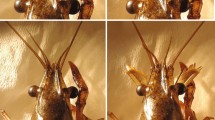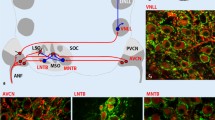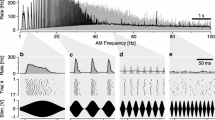Summary
The tarsi of the modified front legs (whips) of the whip spider Heterophrynus elaphus contain two afferent giant fibers, GN1 and GN2, with diameters at the tibia-tarsus joint of ca. 21 μm and 14 μm, respectively. The somata of these two neurons lie in the periphery, about 25 cm away from the CNS. These two neurons are interneurons which receive mechanoreceptive inputs from approximately 750 and 1500 bristles, respectively. The receptive fields of GN1 and GN2 overlap; they extend for 40 mm (GN1) and 90 mm (GN2) along the length of the tarsus. About 90% of the synapses onto the giant fibers are axo-axonic. Mechanical stimulation of a single bristle is sufficient to elicit action potentials in one or both interneurons. The response of the interneurons adapts quickly. Average conduction time from the soma to the CNS is 45 ms for GN1 and 55 ms for GN2. Mean conduction velocities are 5.5 and 4.2 m/s, respectively. Activity in the giant fibers does not elicit a motor response; hence the giant fibers do not mediate an escape response. Possible functions of these giant fibers are discussed and compared to those of giant fiber systems in other arthropods.
Similar content being viewed by others
Abbreviations
- GN :
-
giant neuron
- S :
-
segment
References
Bacon JP, Murphey RK (1984) Receptive fields of cricket giant interneurones are related to their dendritic structure. J Physiol 352:601–623
Beck L, Görke K (1974) Tagesperiodik, Revierverhalten und Beutefang der Geißelspinne Admetus pumilio C.L. Koch im Freiland. Z Tierpsychol 35:173–186
Beck L, Foelix RF, Gödeke E, Kaiser R (1977) Morphologie, Larvalentwicklung und Haarsensillen des Tastbeinpaares der Geißelspinne Heterophrynus longicornis Butler (Arach., Amblypygi). Zoomorphologie 88:259–276
Blagburn JM, Beadle DJ (1982) Morphology of identified cereal afforents and giant interneurones in the hatchling cockroach Periplaneta americana. J Exp Biol 97:421–426
Calabrese RL, Kennedy D (1974) Multiple sites of spike initiation in a single dendritic system. Brain Res 82:316–321
Callee JJ, Guillet JC, Pichon Y, Boistel J (1971) Further studies on synaptic transmission in insects. II. Relations between sensory information and its synaptic integration at the level of a single giant axon in the cockroach. J Exp Biol 55:123–149
Farley RD, Milburn NS (1969) Structure and function of the giant fibre system in the cockroach Periplaneta americana. J Insect Physiol 15:457–476
Foelix RF (1975) Occurrence of synapses in peripheral sensory nerves of arachnids. Nature 254:146–148
Foelix RF (1976) Rezeptoren und periphere synaptische Verschaltungen bei verschiedenen Arachnida. Entomologia Germ 3:83–87
Foelix RF (1985) Sensory nerves and peripheral synapses. In: Barth FG (ed) Neurobiology of arachnids. Springer, Berlin Heidelberg New York, pp 189–200
Foelix RF, Troyer D (1980) Giant neurons and associated synapses in the peripheral nervous system of whip spiders. J Neurocytol 9:517–535
Foelix RF, Chu-Wang I-W, Beck L (1975) Fine structure of tarsal sensory organs in the whip spider Admetus pumilio (Amblypygi, Arachnida). Tissue Cell 7:331–346
Hayes WF, Barber SB (1982) Peripheral synapses in Limulus chemoreceptors. Comp Biochem Physiol 72A:287–293
Hughes GM, Wiersma CAG (1960) Neuronal pathways and synaptic connexions in the abdominal cord of the crayfish. J Exp Biol 37:291–307
Igelmund P (1984) Elektrophysiologische und morphologische Untersuchungen zur Funktion peripherer Riesenneurone in den Tastbeinen der Geißelspinne Heterophrynus elaphus Pocock. Dissertation, Universität zu Köln
Igelmund P (1987) Morphology, sense organs, and regeneration of the forelegs (whips) of the whip spider Heterophrynus elaphus (Arachnida, Amblypygi). J Morphol 193:75–89
Igelmund P (1988) Bristles change their structure during larval development in the whip spider Heterophrynus elaphus: specialization for transduction of wind stimuli? In: Eisner N, Barth FG (eds): Sense organs, interfaces between environment and behaviour. Proc 16th Göttingen Neurobiology Conference. Thieme, Stuttgart New York, p. 338
Igelmund P, Wendler G (1991) The giant fibre system in the forelegs (whips) of the whip spider Heterophrynus elaphus Pocock (Arachnida: Amblypygi). J Comp Physiol A 168:63–73
King DG (1977) An interneuron in Drosophila synapses within a peripheral nerve onto the dorsal longitudinal muscle motor neurons. Neurosci Abstr 3:180
King DG, Wyman RJ (1980) Anatomy of the giant fibre pathway in Drosophila. I. Three thoracic components of the pathway. J Neurocytol 9:753–770
Krämer K, Markl H (1978) Flight-inhibition on ground contact in the American cockroach, Periplaneta americana. I. Contact receptors and a model for their central connections. J Insect Physiol 24:577–586
Levine J, Tracey D (1973) Structure and function of the giant motorneuron of Drosophila melanogaster. J Comp Physiol 87:213–235
Matsumoto SG, Murphey RK (1977) The cercus-to-giant interneuron system of crickets. IV. Patterns of connectivity between receptors and the medial giant interneuron. J Comp Physiol 119:319–330
Milburn NS, Bentley DR (1971) On the dendritic topology and activation of cockroach giant interneurons. J Insect Physiol 17:607–623
Murphey RK (1983) Maps in the insect nervous system, their implications for synaptic connectivity and target location in the real world. In: Huber F, Markl H (eds): Neuroethology and behavioral physiology. Springer, Berlin Heidelberg New York, pp 176–188
Murphey RK (1985) A second cricket cereal sensory system: bristle hairs and the interneurons they activate. J Comp Physiol A 156:357–367
Murphey RK, Palka J, Hustert R (1977) The cercus-to-giant interneuron system of crickets. II. Response characteristics of two giant interneurons. J Comp Physiol 119:285–300
Murphey RK, Jacklet A, Schuster L (1980) A topographic map of sensory cell terminal arborizations in the cricket CNS: Correlation with birthday and position in a sensory array. J Comp Neurol 191:53–64
Palka J, Olberg R (1977) The cercus-to-giant interneuron system of crickets. III. Receptive field organization. J Comp Physiol 119:301–317
Ritzmann RE, Camhi JM (1978) Excitation of leg motor neurons by giant interneurons in the cockroach, Periplaneta americana. J Comp Physiol 125:305–316
Runhaar G (1982) Neuroanatomie und Neurophysiologie des Abdomen der Stabheuschrecke (Carausius morosus Br.). Dissertation, Universität zu Köln
Sigvardt KA, Hagiwara G, Wine JJ (1982) Mechanosensory integration in the crayfish abdominal nervous system: Structural and physiological differences between interneurons with single and multiple spike initiating sites. J Comp Physiol 148:143–157
Umbach JA, Lang F (1981) Synaptic interaction between the giant interneuron and the giant motorneuron in the hermit crab, Paguruspollicarus. Comp Biochem Physiol 68A:49–53
Valentino KL (1977) Identified neurons make identical synapses in Musca and Drosophila. Neurosci Abstr 3:190
Weygoldt P (1972a) Admetus pumilio (Tarantulidae), Kampfverhalten. Encycl Cinem Göttingen (E 1859)
Weygoldt P (1972b) Admetus pumilio (Tarantulidae), Paarungsverhalten. Encycl Cinem Göttingen (E 1860)
Weygoldt P (1977) Kampf, Paarungsverhalten, Spermatophoren-morphologie und weibliche Genitalien bei neotropischen Geißelspinnen (Amblypygi, Arachnida). Zoomorphologie 86:271–286
Zucker RS (1972a) Crayfish escape behavior and central synapses. I. Neural circuit exciting lateral giant fiber. J Neurophysiol 35:599–620
Zucker RS (1972b) Crayfish escape behavior and central synapses. II. Electrical junctions and dendrite spikes in fast flexor motoneurons. J Neurophysiol 35:638–651
Zucker RS, Kennedy D, Selverston AI (1971) Neuronal circuit mediating escape response in crayfish. Science 173:645–650
Author information
Authors and Affiliations
Rights and permissions
About this article
Cite this article
Igelmund, P., Wendler, G. Morphology and physiology of peripheral giant interneurons in the forelegs (whips) of the whip spider Heterophrynus elaphus Pocock (Arachnida: Amblypygi). J Comp Physiol A 168, 75–83 (1991). https://doi.org/10.1007/BF00217105
Accepted:
Issue Date:
DOI: https://doi.org/10.1007/BF00217105




